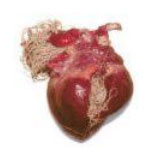What is Heartworm Disease?
Heartworm disease (HWD) is a severe infestation of the heart by worms, from 6′-12″ in length. The worms invade the heart and arteries to the lungs impairing their ability to function. It is a horrific disease that no dog should have to endure. HWD results in heart failure and/or serious disease of the liver and kidneys. Untreated heartworm disease is usually fatal. The image below shows a dog’s heart infected with heartworms.
How does a Dog Become Infected?
Transmission occurs when a mosquito bites an infected dog and ingests heartworm larvae (baby heartworms), which live in the dog’s bloodstream. When the insect bites another dog, some of the larvae are injected under the skin. The larvae grow for 3-4 months and eventually make their way into the heart where they develop into adults.
How is It Prevented?
Heartworm disease is completely preventable by the consistent administration of monthly heartworm preventive medication. These medications kill the microfilaria deposited in the blood stream by mosquitoes before they can invade the heart, mature, consume the heart, and kill the dog. Yet because of the ignorance about heartworm disease or indifference of some dog owners, rescue groups across the nation receive far too many dogs who are heartworm positive.
Treatment Protocol
Fortunately, there is a cure, though it is rough on the dogs and their caretakers. Most dogs with heartworm disease do survive the treatment with the loving, knowledgeable care of their concerned caretakers.
The dog receives an intramuscular injection deep in the lower back muscles. This is a painful injection with a painful substance and it is common for the patient to be very sore at home afterward.
In 30 days, the dog comes back for a second and third injection, 24 hours apart. After each treatment, the patient must be strictly confined for one month.
- No walks, except short leash walks for potty breaks. No further than 200 yards.
- No running, playing, digging, swimming, etc.
- Limit exposure to extremes of temperature.
- No stress and stressful situations or anything that will raise the dog’s heart rate.
- The dog must be kept quiet at all times.
- If it is difficult to curb the dog’s natural tendency to play, he must be confined to a crate.
The reason for this is, as the worms die, they disintegrate over time. If the dog’s heart rate goes up, it is more likely that big pieces of the worms can break off. These big pieces can lodge in the blood vessels to the lungs and cause serious problems and even sudden DEATH.
Watch for:
- Coughing
- Fever
- Nose bleeds
If any of these symptoms occur, call the vet who performed the treatment immediately. If it is after hours, contact the closest emergency vet. The most critical time is 10-21 days following a treatment, but problems can occur anytime in the following month.
And for our Feline Friends…
Heartworm disease in cats is a serious and potentially fatal condition caused by the same parasite that causes heartworm disease in dogs . New research shows a potential for more severe reactions and even sudden death in cats.
How do cats get heartworm disease?
Cats get heartworm disease the same way dogs get it. Mosquitoes transmit the disease by biting an infected animal, then passing the infection on to other animals they bite.
Where are cats at risk for heartworm infection?
Cats are at risk wherever dogs are at risk, including cats that live indoors. In fact, some studies estimate that 70% of cats may be at risk in areas where there are heartworm-infected dogs.
How can heartworm disease be treated?
Currently there is no approved product for treatment of heartworm disease in cats.
What can I do to prevent heartworm disease in my cat?
Prevention is your best option. Ask your veterinarian for more information.




